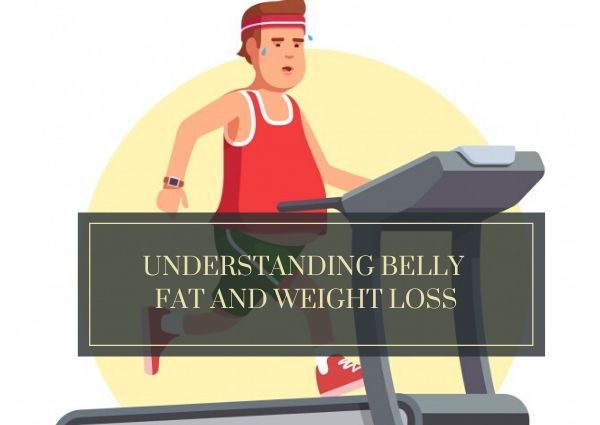Understanding Belly Fat And Weight Loss

Understanding Belly Fat And Weight Loss
In the following, we are going to be discussing a very important topic that’s “Understanding belly fat and weight loss”. Let’s discuss this. There are plenty of names for the fat many of us wish we could trim from our middles like Potbelly, Tummy pooch or Muffin top. Aiming for a flatter stomach isn’t just a matter of appearances: Over the last several years, experts have discovered that where you carry your fat makes a big difference to your health as well as belly fat has emerged as particularly very harmful.
If you’re carrying the extra amount of fat or weight around your waist, it could be a sign that you have unhealthy amounts of visceral fat, which deposits deep in the belly area, settling behind the abdominal muscles around vital/important organs. Also known as abdominal fat, it acts like an organ itself, secreting hormones, immune-system chemicals and other compounds that can profoundly influence the body’s functioning. Some of these substances end up in the liver, where they can affect the production of blood fats, increasing LDL (bad) cholesterol and triglycerides and lowering HDL (good) cholesterol.
What might even be more important is that visceral fat puts out substances that increase inflammation in the body. This may explain why belly fat is associated with insulin resistance and diabetes, heart disease and cancers of the breast, liver, kidney, and pancreas. You don’t really have to be obese or overweight to have visceral fat. People who are considered “normal weight” by the body mass index scale can even have surprisingly high levels of the disease-causing fat.
How It Happens
Where extra pounds settle on our bodies is a matter of genetics, as well as other factors we will control. Some people are more prone to having an apple shape—rounder in the middle; others are more likely to be a pear shape—wider at the bottom, in the hips and butt. You can most likely see body-shape trends in your family. Pear-shaped individuals tend to have more subcutaneous fat (the kind that lies just beneath your skin), whereas those who are more apple-shaped often have more visceral fat.
Aging changes our bodies more than we’d like, however the more you know regarding what’s going on, the more you’ll take steps to do something regarding it. Drops in muscle mass that occur with aging will make it harder to burn calories efficiently, and thus, shed pounds or maintain your weight. Men and women ought to strength train in order to fight the natural decline in muscle mass. For women, the dips in estrogen that occur after menopause play an even larger role in how your body stores fat, particularly the dangerous abdominal fat.
Even-though this all might sound quite daunting, there’s actually good news: while subcutaneous fat is notoriously tough to shed (think cellulite), visceral fat responds more easily to diet and exercise changes. Here are a number of easy things you can do today to keep belly fat under control.
Measure Your Waist
Your waist circumference is a sign that you’re carrying too much belly fat. Measure the area just above your hip bones. A healthy cutoff is less than 35 inches for women and less than 40 inches for men. (It’s lower for Asians: less than 31.5 inches for ladies and less than 35.5 inches for men is considered healthy.) You can go a step further if your BMI is below 25. In that case, WHR (waist-to-hip ratio) is a much better indicator of your belly fat. In order to calculate this number, divide the circumference of your waist by your hip circumference. A healthy WHR (waist-to-hip ratio) is 0.90 or less for men as well as 0.80 or less for women.
Get Moving
Exercise offers a one-two punch against visceral fat. Aerobic exercise helps you keep your weight in check or under control while strength coaching/training helps you maintain or increase your muscle mass, which burns more calories than fat tissue does. Not sure where to start? Walking is a great activity that almost anyone can do. Don’t bother with spot training—sit-ups and crunches can strengthen your core, but they won’t help you lose weight in this area. For this Best Dietician In Delhi For Weight Loss are there.
Eat A Healthy Diet
It’s quite easy to be tempted by the claims of fad diets or supplements or foods that supposedly help burn your belly fat. But remember the previous adage: If it sounds too good to be true, it probably is. A better strategy is to focus on eating a nutritious, balanced diet. For most individuals, this will include whole-grains, plenty of fresh fruits and vegetables, lean protein and healthy fats.
Keep Stress In Check
If you’re like most of us, there’s no shortage of stress in your life, whether it’s due to financial issues, family matters or work problems. But stress will lead to weight gain or make it tough to lose extra pounds by changing your body chemistry and behaviors.
Get Your Rest
Do you typically push back your bedtime to gain some hours to finish up work, get ahead on household chores or just catch up on your favorite TV shows? You may want to rethink this. Numerous studies have shown a connection between skimping on sleep and weight gain. Most people need seven to 9 hours a night, so make sure you do your best to get some decent sleep. Sleep apnea, a condition where the airway is obstructed during sleep, can also increase abdominal fat (and vice versa), so it’s important to see your doctor if you or a loved one suspects you may not be breathing properly at night.
Calories are found in most foods. When you consume or eat calories your body uses them as fuel. The leftover calories that your body does not use are stored as fat. One pound of fat is roughly 3,500 calories. Your BMR also called your Basal metabolic rate, is the number of calories your body burns in a single day from performing basic functions like breathing and pumping blood. Think of it as the calories you’d burn if you sat on the couch all day. This is the number of calories your body needs to function.
When you create a deficit your body can turn to the in your fat stores to function properly — burning those unwanted pounds away.In order to lose one pound of fat, you need to make a caloric deficit of 3,500 calories. This means you need a deficit of around 500 calories per day in order to lose one pound per week.
How To Create A Calorie Deficit
Change your diet and eat fewer calories than you burn every day. If you eat five hundred fewer calories than your BMR every day for a week, you’ll lose about one pound of fat. Introducing physical activity and burning a lot of calories than you consume. If you eat or consume enough calories to support your BMR, however, exercise more, you’ll create a caloric deficit simply by burning extra calories.
If you cut just two hundred calories each day from your diet and burned just three hundred extra calories every day by exercising, you’d lose about one pound per week.A combination of diet and exercise is the easiest method to lose weight because it requires only small tweaks to your lifestyle.
Example
Eliminate Calories
- 1 Can of Soda = 140 Calories
- 1 TBSP of Butter = 102 Calories
Add Physical Activity
- 20 Minutes of Circuit Training = 113 Calories
- 30 Minutes of Walking = 179 Calories
